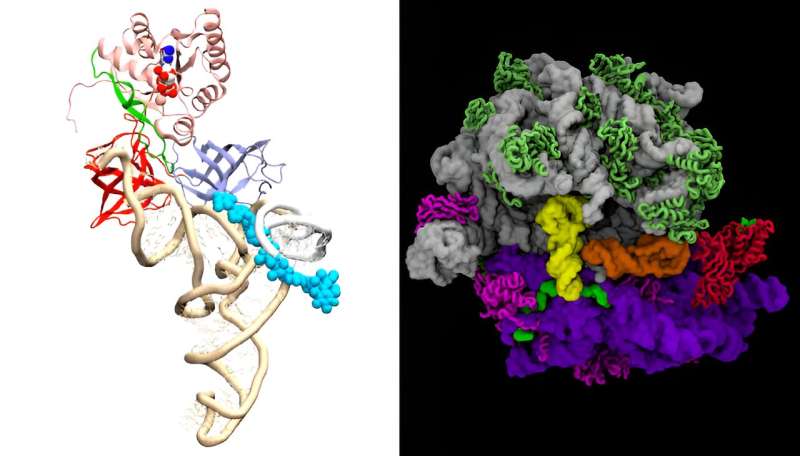This article has been reviewed according to Science X's editorial process and policies. Editors have highlighted the following attributes while ensuring the content's credibility:
fact-checked
peer-reviewed publication
trusted source
proofread
Supercomputer simulation tackles problem of drug-resistant bacteria

A first-ever, atom-by-atom supercomputer simulation shows how antibiotics kill bacteria and illustrates other processes of the molecular machinery in living cells. The research opens fresh pathways to improving antibiotics, designing new ones to fight drug-resistant bacteria and developing vaccines for viruses such as SARS-CoV-2, which causes COVID-19.
"The ribosome is the central information-processing molecular machine in all life forms. It has to decipher information about accepting correct amino acids and rejecting incorrect amino acids for building proteins in the cell," said Karissa Sanbonmatsu, a structural biologist at Los Alamos National Laboratory.
Sanbonmatsu is co-author of a new paper about the breakthrough simulation published in Nature Communications.
"Using the supercomputers at Los Alamos, we're able to image this process atom for atom and show how antibiotics affect that process," Sanbonmatsu said. "Studies like these are critical for combatting the emerging crisis of antibiotic-resistant bacteria."
"Antimicrobial resistance is on the rise due to overuse in medicine and agriculture," said Dylan Girodat, first author of the paper, who developed the project with Sanbonmatsu. Now an assistant professor at the University of Arkansas, Girodat was a postdoctoral fellow at Los Alamos when he and Sanbonmatsu performed the research. "To combat antimicrobial resistance, we must understand how conventional antibiotics work if we want to develop novel ones."
Sanbonmatsu's lab at Los Alamos coordinated the ribosome research, which also has implications for cancer treatments and understanding the origins of life. The research closely integrated single-molecule experiments led by Scott Blanchard, a dynamic structural biologist at St. Jude Children's Research Hospital, with simulations on a Los Alamos supercomputer by Girodat.
Genetic messenger
Messenger RNA, or mRNA, carries codes with the information for creating specific proteins in a cell. The ribosome decodes this genetic information by reading codes from the mRNA, pulling the mRNA through the ribosome similarly to the way a cassette tape player "reads" information off a tape. The ribosome looks up the codes in a molecular-information table, which is a suite of molecules called transfer RNAs, or tRNA, to select specific amino acids and manufactures proteins based on those encoded instructions.
For each code unit in the mRNA, the ribosome sorts through amino acids and chooses the correct amino acid corresponding to that code unit, while rejecting incorrect amino acids. tRNA molecules deliver the essential building blocks of proteins to the ribosomes. The ribosome then assembles a protein by adding the correct amino acid.
Many antibiotics work by gumming up this molecular machinery in bacteria's ribosomes, Sanbonmatsu said. The drugs either grind the machine to a halt or cause errors in the information processing, resulting in malformed proteins, killing the bacteria.
In contrast, mRNA-based vaccines target human ribosomes, convincing them to make COVID virus proteins (the spike protein), which helps inoculate the body against the virus. A deeper understanding, attained from supercomputers, of how the ribosome can read mRNA will help researchers design more effective antibiotics and vaccines.
Massive supercomputers simulate massive molecules
"About 50% of all antibiotics inhibit ribosome function, so we know that this is an effective strategy for antibiotics," Girodat said. "To develop new antibiotics, we need to understand how ribosomes work at an atomic level."
To that end, the research team simulated the molecular dynamics of the interactions between ribosomes and tRNA.
"Our simulations revealed that incorrect tRNA molecules do not adopt the proper geometry when interacting with ribosomes," Girodat said. "By introducing the antibiotics gentamicin, neomycin, evernimicin and hygromycin in these simulations, we demonstrated that antibiotics influence the geometry of tRNA, causing the ribosome to incorporate incorrect tRNA or none at all."
That kills the bacteria.
"Ribosomes are massive biomolecules, and achieving the necessary timescales to observe ribosome dynamics requires massive computational resources, such as those available at the high-performance compute cluster at Los Alamos," Girodat said.
More information: Dylan Girodat et al, Geometric alignment of aminoacyl-tRNA relative to catalytic centers of the ribosome underpins accurate mRNA decoding, Nature Communications (2023). DOI: 10.1038/s41467-023-40404-9
Journal information: Nature Communications
Provided by Los Alamos National Laboratory



















